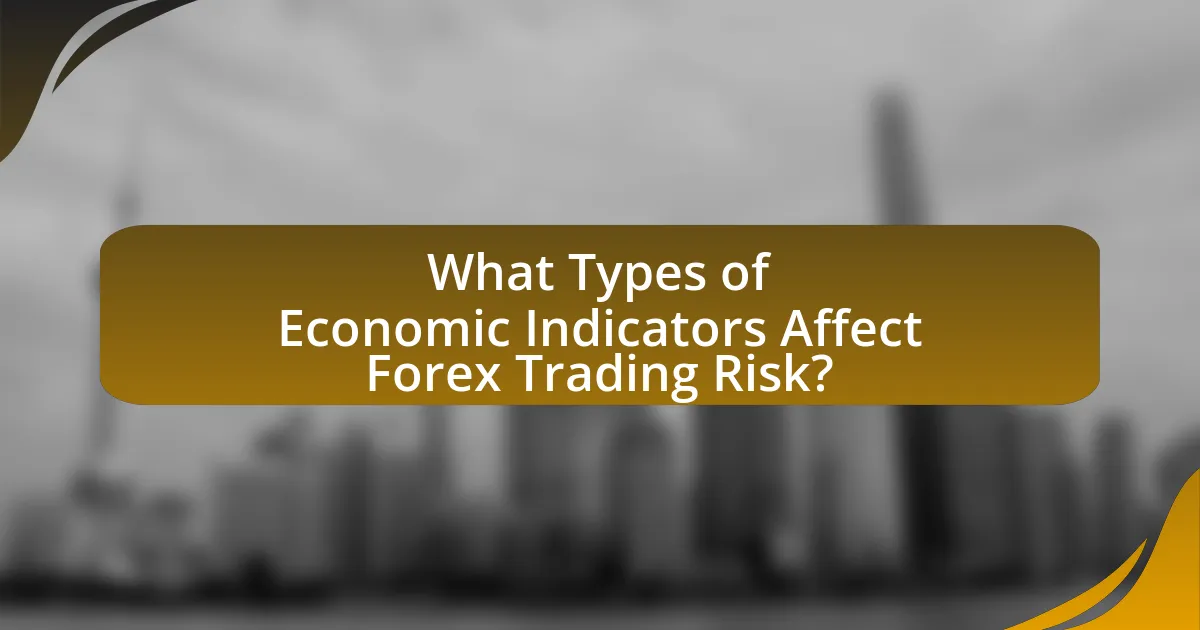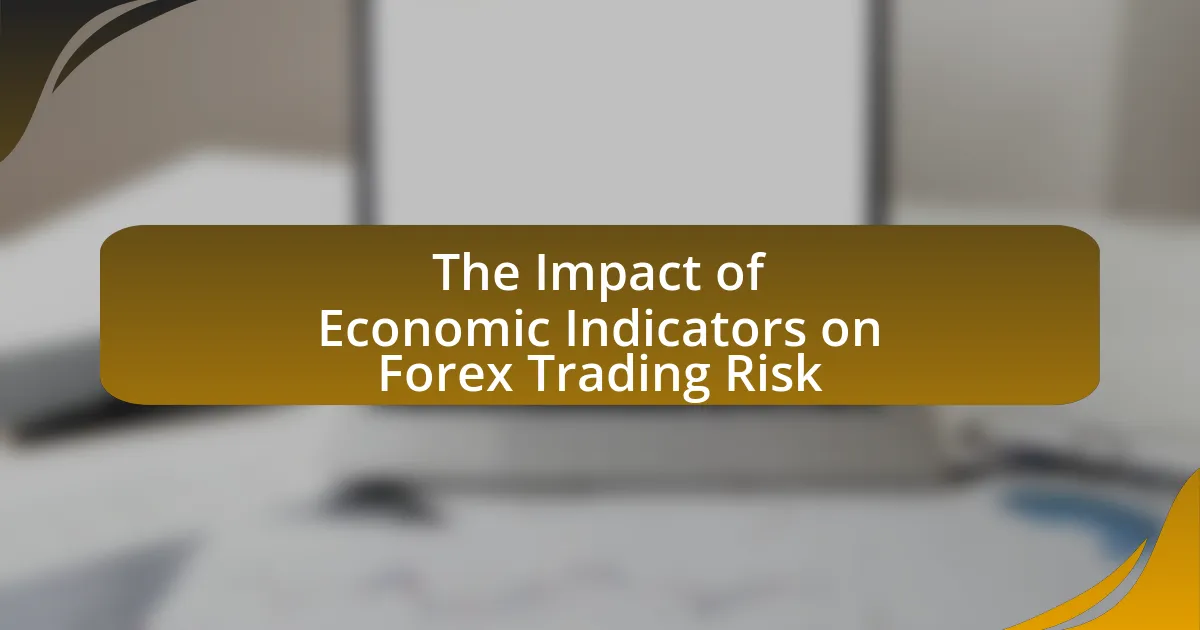Economic indicators are vital statistical metrics that reflect the economic performance and health of a country, significantly influencing currency values in the Forex market. Key indicators such as GDP growth rates, unemployment rates, inflation rates, and consumer confidence indices are essential for traders to assess market movements and manage risks. The article explores how these indicators impact currency values, the types of indicators traders monitor, and the risks associated with misinterpreting economic data. Additionally, it discusses strategies for mitigating risks linked to economic announcements and emphasizes the importance of a systematic approach to analyzing economic indicators for informed trading decisions.

What are Economic Indicators and Their Role in Forex Trading Risk?
Economic indicators are statistical metrics that provide insights into the economic performance and health of a country, influencing currency values in the Forex market. These indicators, such as GDP growth rates, unemployment rates, inflation rates, and consumer confidence indices, serve as critical tools for traders to assess potential market movements and risks. For instance, a higher-than-expected GDP growth rate typically strengthens a currency, while rising unemployment may weaken it. Historical data shows that significant economic announcements can lead to increased volatility in currency pairs, highlighting the importance of these indicators in managing Forex trading risk.
How do economic indicators influence currency values?
Economic indicators significantly influence currency values by providing insights into a country’s economic health, which traders use to make informed decisions. For instance, strong GDP growth typically leads to an appreciation of a currency, as it suggests a robust economy attracting foreign investment. Conversely, high unemployment rates can lead to currency depreciation, as they indicate economic weakness. Historical data shows that the U.S. dollar often strengthens following positive employment reports, such as the Non-Farm Payrolls, which reflect job creation and economic expansion. Thus, economic indicators serve as critical tools for predicting currency movements in the foreign exchange market.
What are the key economic indicators that traders monitor?
Traders monitor several key economic indicators to assess market conditions and make informed trading decisions. These indicators include Gross Domestic Product (GDP), which measures the overall economic output and growth; unemployment rates, indicating labor market health; inflation rates, often assessed through the Consumer Price Index (CPI), which reflect purchasing power and cost of living; interest rates set by central banks, influencing borrowing costs and investment; and trade balances, which show the difference between exports and imports. Each of these indicators provides critical insights into economic performance and potential market movements, helping traders gauge risk and opportunity in the forex market.
How do these indicators reflect the health of an economy?
Economic indicators reflect the health of an economy by providing measurable data that indicates economic performance and trends. For instance, Gross Domestic Product (GDP) growth rates signal overall economic activity; a rising GDP suggests a growing economy, while a declining GDP indicates contraction. Unemployment rates serve as another indicator; lower unemployment typically reflects a robust economy with job creation, whereas higher unemployment suggests economic distress. Inflation rates also play a crucial role; moderate inflation can indicate a healthy economy, while hyperinflation or deflation can signal instability. These indicators are used by analysts and traders to assess economic conditions, make predictions, and manage risks in forex trading.
Why is understanding economic indicators crucial for Forex traders?
Understanding economic indicators is crucial for Forex traders because these indicators provide insights into a country’s economic health, influencing currency value fluctuations. Economic indicators such as GDP growth rates, unemployment figures, and inflation rates directly affect monetary policy decisions made by central banks, which in turn impact exchange rates. For instance, a stronger-than-expected GDP growth report can lead to an appreciation of a currency, as it may prompt a central bank to raise interest rates to control inflation. Historical data shows that major currency pairs often react significantly to economic releases; for example, the U.S. dollar typically strengthens following positive employment data, as seen in the monthly Non-Farm Payroll report. Thus, by analyzing these indicators, Forex traders can make informed decisions, manage risks effectively, and capitalize on market movements.
How can economic indicators predict market movements?
Economic indicators can predict market movements by providing insights into the overall health of an economy, which influences investor sentiment and trading decisions. For instance, indicators such as GDP growth rates, unemployment figures, and inflation rates directly affect currency values; a strong GDP growth typically leads to a stronger currency as it signals economic stability and potential interest rate hikes. Historical data shows that the release of key economic indicators often results in significant price volatility in forex markets, as traders react to the implications of these figures on future monetary policy. For example, the U.S. Non-Farm Payroll report, which measures employment changes, has historically caused sharp movements in the USD, demonstrating the predictive power of economic indicators on market behavior.
What risks arise from misinterpreting economic data?
Misinterpreting economic data can lead to significant financial risks, particularly in Forex trading. Traders may make poor investment decisions based on inaccurate interpretations, resulting in substantial losses. For instance, if a trader misreads a country’s GDP growth as positive when it is actually declining, they may invest heavily in that currency, leading to unexpected losses when the market corrects itself. Historical examples, such as the 2008 financial crisis, illustrate how misinterpretation of economic indicators can trigger widespread market volatility and financial instability. Accurate interpretation of economic data is crucial for informed decision-making in Forex trading.

What Types of Economic Indicators Affect Forex Trading Risk?
Economic indicators that affect Forex trading risk include interest rates, inflation rates, employment figures, and GDP growth. Interest rates, set by central banks, directly influence currency value; for example, a rise in interest rates typically strengthens a currency as it offers higher returns on investments. Inflation rates indicate the purchasing power of a currency; higher inflation can lead to depreciation. Employment figures, such as non-farm payrolls in the U.S., reflect economic health and can cause volatility in currency markets. GDP growth rates provide insight into economic performance; stronger growth often leads to currency appreciation. These indicators are closely monitored by traders to assess potential risks and opportunities in Forex markets.
What are leading, lagging, and coincident indicators?
Leading indicators are economic factors that change before the economy starts to follow a particular pattern, providing predictive insights into future economic activity. Examples include stock market performance and new housing permits, which often signal upcoming economic trends. Lagging indicators, on the other hand, are metrics that reflect the economy’s performance after changes have occurred, such as unemployment rates and GDP growth, confirming trends rather than predicting them. Coincident indicators occur simultaneously with the economic cycle, providing real-time insights into the current state of the economy, such as retail sales and industrial production. These indicators are crucial for forex traders as they assess market conditions and make informed trading decisions based on economic forecasts and trends.
How do leading indicators provide foresight in Forex trading?
Leading indicators provide foresight in Forex trading by signaling potential future price movements before they occur. These indicators, such as economic reports, consumer sentiment surveys, and manufacturing indices, help traders anticipate market trends and shifts in currency values. For instance, the Purchasing Managers’ Index (PMI) often predicts economic expansion or contraction, allowing traders to make informed decisions based on expected currency strength or weakness. Historical data shows that traders who utilize leading indicators can achieve higher accuracy in forecasting market movements, as these indicators often precede actual economic changes, thus enhancing trading strategies and risk management.
What role do lagging indicators play in confirming trends?
Lagging indicators play a crucial role in confirming trends by providing data that reflects past performance, which traders use to validate the direction of a market movement. These indicators, such as moving averages and the unemployment rate, are based on historical data and help traders identify whether a trend is established and likely to continue. For instance, a moving average crossover can confirm an upward trend when the short-term average crosses above the long-term average, indicating sustained price momentum. This confirmation is essential in Forex trading, as it reduces the risk of false signals and enhances decision-making based on established market behavior.
Which specific economic indicators are most impactful in Forex trading?
The most impactful economic indicators in Forex trading are interest rates, inflation rates, employment data, and GDP growth. Interest rates, set by central banks, directly influence currency value; for example, a rise in interest rates typically strengthens a currency as it offers higher returns on investments. Inflation rates indicate the purchasing power of a currency; lower inflation usually correlates with a stronger currency. Employment data, such as non-farm payrolls in the U.S., reflects economic health and can lead to currency appreciation or depreciation based on job growth or loss. GDP growth measures overall economic performance; stronger GDP growth often results in a stronger currency as it signals a robust economy. These indicators are closely monitored by traders and can lead to significant market movements, as evidenced by historical reactions to Federal Reserve interest rate announcements or U.S. employment reports.
How do interest rates influence Forex market volatility?
Interest rates significantly influence Forex market volatility by affecting currency values and investor behavior. When a central bank raises interest rates, it typically strengthens the national currency as higher rates offer better returns on investments denominated in that currency. For example, following the U.S. Federal Reserve’s interest rate hikes in 2015, the U.S. dollar appreciated against several currencies, leading to increased volatility in the Forex market. Conversely, when interest rates are lowered, the currency may weaken, prompting traders to react, which can also heighten volatility. Historical data shows that major announcements regarding interest rate changes often lead to sharp price movements in currency pairs, illustrating the direct correlation between interest rates and Forex market fluctuations.
What is the significance of GDP reports in Forex trading?
GDP reports are significant in Forex trading as they provide a comprehensive measure of a country’s economic performance, influencing currency valuation. When a GDP report indicates strong economic growth, it typically leads to an appreciation of the national currency, as traders anticipate higher interest rates and increased investment. Conversely, weak GDP growth can result in currency depreciation due to expectations of lower interest rates and reduced economic activity. Historical data shows that major currency pairs often experience volatility around GDP report releases, reflecting traders’ reactions to the economic outlook presented in these reports. For instance, the U.S. GDP report can significantly impact the USD, affecting its value against other currencies based on the growth figures reported.

How Can Traders Mitigate Risks Associated with Economic Indicators?
Traders can mitigate risks associated with economic indicators by employing a combination of strategies such as diversification, using stop-loss orders, and staying informed about economic releases. Diversification reduces exposure to any single economic event by spreading investments across various assets or currency pairs, thereby minimizing potential losses. Utilizing stop-loss orders allows traders to automatically exit positions at predetermined levels, limiting losses when economic indicators lead to unfavorable market movements. Additionally, staying informed about upcoming economic releases and understanding their potential impact on the market enables traders to make more informed decisions, reducing the likelihood of adverse effects on their trading positions. For instance, the U.S. Bureau of Economic Analysis regularly publishes GDP data, which significantly influences currency valuations; traders who anticipate this release can adjust their strategies accordingly to mitigate risks.
What strategies can traders employ to manage risks from economic data releases?
Traders can manage risks from economic data releases by employing strategies such as using stop-loss orders, diversifying their portfolios, and analyzing historical data trends. Stop-loss orders allow traders to set predetermined exit points to limit potential losses when market volatility spikes due to unexpected economic data. Diversification across different currency pairs can mitigate the impact of adverse movements in any single asset. Additionally, analyzing historical data trends helps traders anticipate market reactions to similar economic releases, enabling them to make informed decisions. For instance, a study by the Bank for International Settlements found that currency pairs often exhibit predictable volatility patterns following major economic announcements, reinforcing the importance of these strategies in risk management.
How can traders prepare for high-impact economic announcements?
Traders can prepare for high-impact economic announcements by analyzing economic calendars and understanding the potential market impact of these events. Economic calendars provide scheduled dates and times for announcements, such as GDP reports or employment figures, which historically lead to increased volatility in currency pairs. For instance, the U.S. Non-Farm Payrolls report often results in significant price movements, as evidenced by a 2019 study showing that major currency pairs can experience volatility spikes of up to 200 pips within minutes of the announcement. Additionally, traders should develop a risk management strategy, such as setting stop-loss orders, to mitigate potential losses during these volatile periods.
What tools and resources can assist in analyzing economic indicators?
Tools and resources that assist in analyzing economic indicators include economic calendars, statistical databases, and analytical software. Economic calendars, such as those provided by Forex Factory or Investing.com, list upcoming economic events and their expected impacts, allowing traders to anticipate market movements. Statistical databases like the Federal Reserve Economic Data (FRED) offer historical data on various economic indicators, enabling in-depth analysis and trend identification. Analytical software, such as MetaTrader or TradingView, provides charting tools and technical analysis features that help traders interpret economic data in relation to market trends. These resources collectively enhance the ability to make informed trading decisions based on economic indicators.
What best practices should Forex traders follow regarding economic indicators?
Forex traders should prioritize understanding and analyzing key economic indicators to make informed trading decisions. This involves regularly monitoring indicators such as GDP growth rates, unemployment figures, inflation rates, and central bank interest rate decisions, as these metrics directly influence currency values. For instance, a rise in GDP typically signals economic strength, which can lead to currency appreciation. Additionally, traders should pay attention to the timing of economic releases, as volatility often spikes around these events, creating both opportunities and risks. Historical data shows that major economic announcements can lead to significant price movements; for example, the U.S. Non-Farm Payroll report often results in increased volatility in the USD. By integrating these practices, traders can better navigate the complexities of the Forex market and manage their risk effectively.
How can traders develop a systematic approach to interpreting economic data?
Traders can develop a systematic approach to interpreting economic data by establishing a structured framework that includes identifying key economic indicators, analyzing historical data trends, and utilizing statistical tools for forecasting. This approach allows traders to make informed decisions based on empirical evidence rather than speculation. For instance, the U.S. Bureau of Economic Analysis provides data on GDP growth rates, which traders can analyze over time to understand economic cycles and their potential impact on currency values. By consistently applying this framework, traders can enhance their ability to predict market movements and manage risks effectively.
What common pitfalls should traders avoid when using economic indicators?
Traders should avoid over-reliance on economic indicators without considering the broader market context. Economic indicators, such as GDP growth rates or unemployment figures, can provide valuable insights, but they may not always reflect real-time market sentiment or geopolitical factors that influence currency movements. For instance, during the COVID-19 pandemic, many economic indicators showed negative trends, yet some currencies strengthened due to safe-haven demand, illustrating that indicators alone can be misleading. Additionally, traders often misinterpret the timing of indicator releases; for example, a positive jobs report may lead to immediate market reactions, but the long-term impact can differ significantly. Therefore, integrating economic indicators with other analytical tools and market news is crucial for informed trading decisions.
